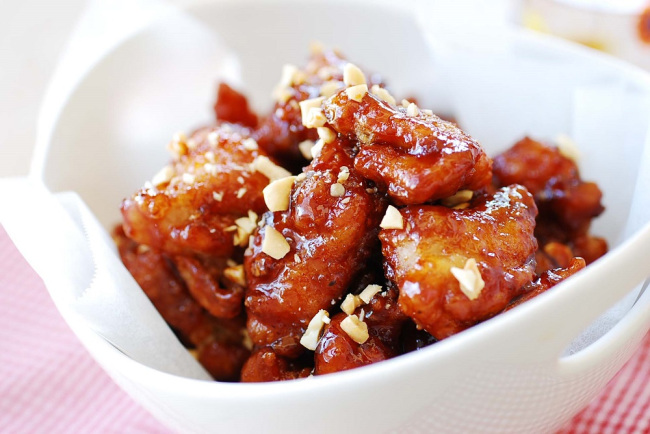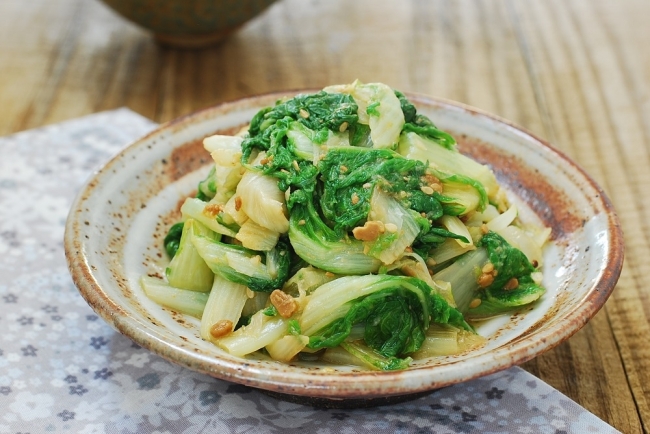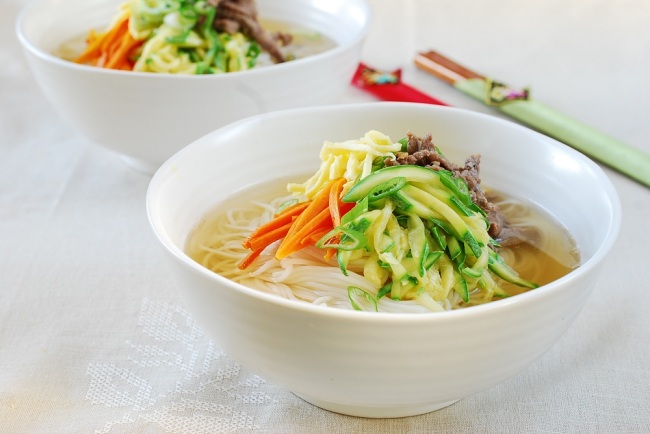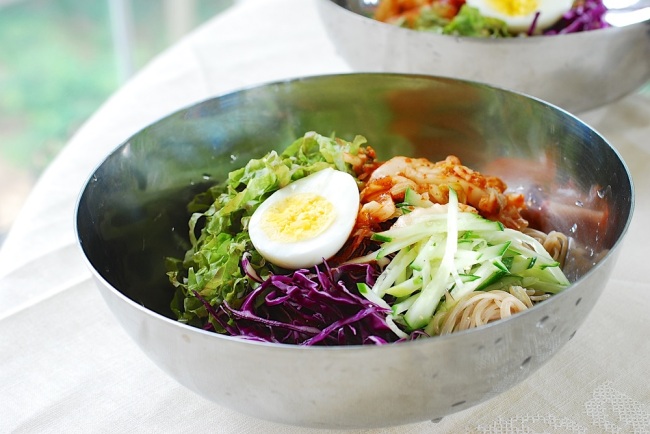Jangjorim is a soy-braised beef dish. It’s a slightly sweet, salty side dish that’s meant to be eaten in small amounts. So, a little bit of meat goes a long way. Back in the day, when beef was scarce, jangjorim was an economical way to put some beef on the table for the whole family. It’s also a popular side dish for lunch boxes. Growing up, it was the most exciting thing to see in my lunch box.
Beef eye round is commonly used, but I prefer brisket (yangjimeori) or shank (satae) because they are more flavorful. Small blocks of beef are first cooked in water, along with a few aromatic vegetables, and then cooked in soy sauce-based broth. The beef will turn tough if cooked in soy sauce from the beginning. I boil the aromatic vegetables, to make a flavorful broth, before adding the beef to cook. Shred a block of beef or two and pour the sauce over to serve.
Ingredients:
● 600 grams beef brisket (or shank)
● 1/2 medium onion
● 2 scallions (white parts)
● 150 grams of Korean radish (mu), cut into big chunks
● 7 garlic cloves
● 3 thin ginger slices (about 3-centimeter rounds)
● 1/2 teaspoon whole peppercorns (or ground pepper to taste)
● 5 tablespoons soy sauce
● 2 tablespoons soup soy sauce
● 3 tablespoons sugar
● 3 tablespoons rice wine (or mirim)
● 2 to 3 chili peppers (dried or fresh green or red peppers)
●1 piece (7-centimeter square) dried kelp
Cut the beef into small blocks (about 5-by-7-centimeter pieces).
In a covered medium pot, bring 6-7 cups of water and the next six ingredients to a boil. Continue to boil for 5 minutes over medium high heat.
Drop the meat into the pot. Bring it to a gentle boil, and remove the scum. Reduce the heat to medium-low. Cover and boil for about 30 minutes.
Remove the meat. Drain the liquid, reserving the broth.
Add 2 cups of the broth back to the pot. (You can save the remaining broth to make a soup or stew later.) Add the meat and sauce ingredients. Bring it to a boil over medium-high heat. Reduce the heat to medium-low, and boil for 30 minutes, until the meat is tender and the sauce is reduced to about one-third. Add the chili peppers and dried kelp with about 7-8 minutes of time remaining.
Remove the kelp, and transfer the meat and sauce to an airtight container.
Shred the meat and pour some sauce over to serve. Keep it refrigerated in an airtight container. It will keep well for up to 10 days. If you want to keep it longer, boil the meat and sauce again after a few days. The meat will become hard in the fridge. You can soften it by leaving the shredded beef out at room temperature for 20 to 30 minutes, or microwaving it for 10-15 seconds.
Beef eye round is commonly used, but I prefer brisket (yangjimeori) or shank (satae) because they are more flavorful. Small blocks of beef are first cooked in water, along with a few aromatic vegetables, and then cooked in soy sauce-based broth. The beef will turn tough if cooked in soy sauce from the beginning. I boil the aromatic vegetables, to make a flavorful broth, before adding the beef to cook. Shred a block of beef or two and pour the sauce over to serve.
Ingredients:
● 600 grams beef brisket (or shank)
● 1/2 medium onion
● 2 scallions (white parts)
● 150 grams of Korean radish (mu), cut into big chunks
● 7 garlic cloves
● 3 thin ginger slices (about 3-centimeter rounds)
● 1/2 teaspoon whole peppercorns (or ground pepper to taste)
● 5 tablespoons soy sauce
● 2 tablespoons soup soy sauce
● 3 tablespoons sugar
● 3 tablespoons rice wine (or mirim)
● 2 to 3 chili peppers (dried or fresh green or red peppers)
●1 piece (7-centimeter square) dried kelp
Cut the beef into small blocks (about 5-by-7-centimeter pieces).
In a covered medium pot, bring 6-7 cups of water and the next six ingredients to a boil. Continue to boil for 5 minutes over medium high heat.
Drop the meat into the pot. Bring it to a gentle boil, and remove the scum. Reduce the heat to medium-low. Cover and boil for about 30 minutes.
Remove the meat. Drain the liquid, reserving the broth.
Add 2 cups of the broth back to the pot. (You can save the remaining broth to make a soup or stew later.) Add the meat and sauce ingredients. Bring it to a boil over medium-high heat. Reduce the heat to medium-low, and boil for 30 minutes, until the meat is tender and the sauce is reduced to about one-third. Add the chili peppers and dried kelp with about 7-8 minutes of time remaining.
Remove the kelp, and transfer the meat and sauce to an airtight container.
Shred the meat and pour some sauce over to serve. Keep it refrigerated in an airtight container. It will keep well for up to 10 days. If you want to keep it longer, boil the meat and sauce again after a few days. The meat will become hard in the fridge. You can soften it by leaving the shredded beef out at room temperature for 20 to 30 minutes, or microwaving it for 10-15 seconds.







